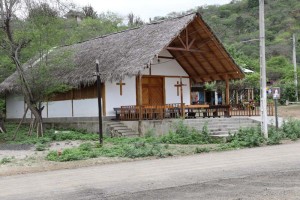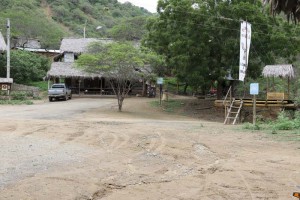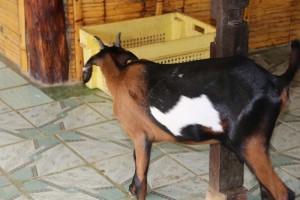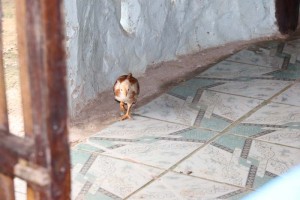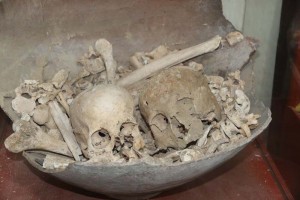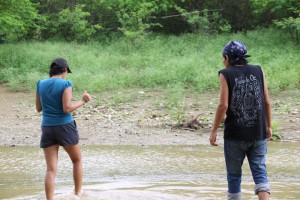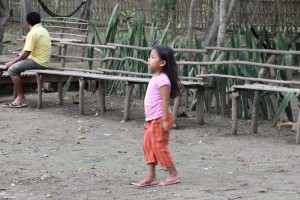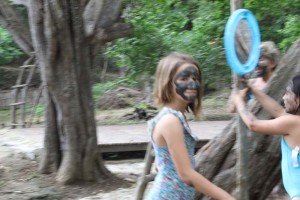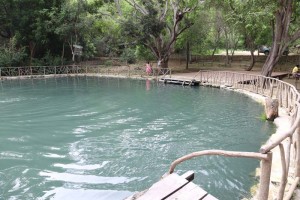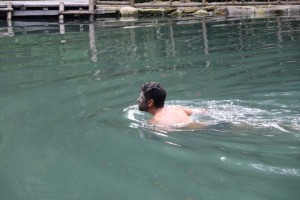As defined “Agua Blanca is a private community within Machalilla National Park hosting remains of one of the most ancient civilizations in South America, the Monteño, along with trails and a sulfur lagoon.”
We arrived at Agua Blanca from Los Frailes beach at lunch time. When asked in the morning if we preferred to have lunch back in Peurto Lopez or to share lunch with the community at AguaBlanca we ,of course, chose Agua Blanca.
Let me try to paint a picture. Stepping out of our car we are in the middle of an intersection of the two dirt roads that make up the village. Numerous people, children, cats, dogs, chickens and goats scoot in and out of the buildings and yards. Some faces turn towards and some don’t. To our left is a church with a covered porch and a dozen or so pews facing towards the road.
All the buildings have thatched roofs and any plastered surface is a dirty white. Straight ahead is the musuem. The only indication of what anything is are little tourist signs marking each building. The street meanders off to the right with several small houses.
A replica raft with a colorful sail marks the intersection to the right. Directly behind us is the restaurant. It too has a thatched roof, dirty white plaster and bamboo framing. We step down two steps from the road and through a gate that is wedged into the mud. Inside to the left is a room under the roof with a window and ledge. A man leans his chin onto his folded hands waiting for us to make first contact. Behind his room is a open door with a purple sheet hanging in the doorway and within is the kitchen. Our guide has a conversation with the man and reports what is available today. We choose and sit at one of the tables with the tablecloth nailed to the table top. The seating area is an open area with the bamboo frame showing under the thatched roof. Some areas of the roof were sagging more than others. Two hammocks hang from the posts behind us. Two stray dogs wander in and position themselves between us and watch. A woman brings out large glasses of a fruit smoothie like drink. Not sure what the fruit is, perhaps passion fruit. It is cold and tastes refreshing. Seeing ice cubes in the glass sparked a bit of fear but we comment that we are up to date with all our shots. The dogs get restless and lie down under the table. All I can picture is fleas hopping from dog to leg. Our meals arrive. A standard plate with a mound of rice, deep fried plantain, a small salad and a fillet of breaded chicken. Always good but by north American palette slightly bland. Dogs have perked up hoping for a morsel. In front of the restaurant a truck dives slowly by, laden with vegetables and fruit. A man hangs out the window with a megaphone pressed to his mouth. Speaking much faster than the truck is traveling he loudly announces his wares. As we eat we see a goat approaching on the road.
He does not hesitate at all but enters through the gate, looks about, glances at us then pushes the purple sheet aside and wanders through the kitchen. A few minutes later I see him on the hill right behind the restaurant. I guess it was a shortcut.
Two chicks and a mother hen are the next visitors as they come in and remove a few insects from the half wall that is between the road and the restaurant. We greet each of our visitors as they arrive with a smile. We finish or meal and gather our things to leave. The dogs also leave, disappointed.
The museum depicts the history of the peoples who live here and the reasons why they are still allowed to live in what is now a national park. It is small and seems to concentrate on the burial methods of their ancestors. Several urns in glass cubes have the remains of different classes of people. Our museum guide is will informed and apparently very knowledgeable about his history. He gives us the tour in Spanish and Aude, our guide, translates.
Leaving the museum our guides bring us through a jungle path stopping to show us excavation sites and points of interest. We cross a river twice.
Leather sandals are not the best for this kind of walk. Had to remove them to cross the water otherwise they would never have dried. Evenually we arrive at the sulfur lagoon and spa. You are given a cup of mud to rub on whatever part of your body you would like. You also have the option of having a masseuse massage your full body with the mud. We were told to let the mud dry and then to wade into the lagoon to wash it off. I have never smelt something so disgusting. The lagoon is over 70% sulfur. It burned the senses.
The walk back to the village was easier along the road. Marianne commented that they should have taken us that way to begin with.
Overall it was a good experience. To learn some of the history was important and haveing the village share some of their food with us was humbling. Everyone in the community has a role they play and they take care of one another. The food gatherers and farmers share the harvest with the ones who work within the town and the ones who take turns being guides. Whatever is left over is shared with visitors.

